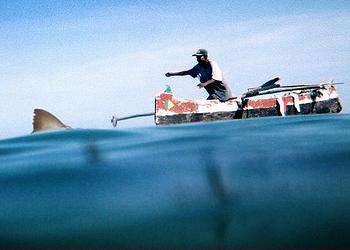
ANTANANARIVO, Madagascar, February 13, 2015 (ENS) – The New York-based Wildlife Conservation Society has assisted the Government of Madagascar to create the country’s first marine sanctuary for sharks as part of a new law to safeguard the country’s marine resources and the communities that rely on them.
At a news conference held in the capital Antananarivo February 2, government officials announced the law establishing a shark sanctuary in Antongil Bay while granting coastal communities exclusive use and management rights for local fishing areas.
The new shark sanctuary is inhabited by 19 species of sharks. A third of these species, including the great hammerhead shark and the zebra shark, are now threatened by unregulated fishing.
The new law restricts international fishing boats from operating in Antongil Bay, a 1,446-square-mile body of water slightly larger than Long Island Sound.

“With the support from Wildlife Conservation Society, we chose a participatory and collaborative approach for the development of this law and management plan and we opted for the search for a balance between fishing activities and ecological integrity to ensure rational and sustainable exploitation of fisheries resources,” said Minister of Marine Resources and Fisheries Sem Ahmad.
The Wildlife Conservation Society has been working in Madagascar for over two decades, a partnership that resulted in the new shark sanctuary.
Alison Clausen, country director of the WCS Madagascar Program, said, “Long-term strategic alliances and partnerships forged with local communities, government agencies such as the Ministry of Marine Resources and Fisheries, and stakeholders during two decades of field presence of WCS investing in wildlife protection and sustainable natural resources management in Antongil Bay is key to this success.”
Madagascar’s local fisheries provide livelihoods and food security for hundreds of thousands of some of the poorest coastal communities in the world. The new law will facilitate a system of co-management between communities, fishers, and government to manage their local fish populations.
The new law legally empowers local communities to manage nearshore fishing grounds through a growing network of locally managed marine areas (LMMAs), 25 of which have already been established with the support of WCS.
The regulations of these areas, including no-take marine reserves and temporary closures, are locally designed and enforced.
By securing management and use rights of LMMAs for local communities for the first time in Madagascar, the law aims to transform marine resources from open access areas that typically result in short-term exploitation at the expense of long-term sustainability to exclusive access for local fishers, who can reap the benefits of managing their own marine resources.

The law also establishes collaborative arrangements between artisanal and industrial fishers, civil society, and government to work together on the sustainable management of fisheries in Antongil Bay.
The regulatory changes build on previous initiatives to decentralize the management of marine resources and establish local fisheries management plans and collaborative management arrangements.
At the 2014 IUCN World Parks Congress, President of Madagascar Hery Rajaonarimampianina said Madagascar “already [has] positive models of locally managed marine areas, of which Madagascar is proud to be a pioneer in the Western Indian Ocean region.”
He emphasized his commitment “to establish legal and regulatory frameworks for community management of marine and coastal resources.”
Venor Rason is a local fisherman and president of the community association managing the LMMA of Analanjahana in the southern part of Antongil Bay. “We are very pleased to hear that this new law that we helped develop has been released,” he said. “It will help us manage sustainably our marine resources by limiting the number of small-scale and industrial fishers allowed to fish in the bay and by delivering fishing licenses to local professional fishers.”
Dr. Ambroise Brenier, marine technical director of the WCS Madagascar Program, said, “This pilot initiative will reduce coral reef degradation, improve abundance of endangered species of sharks, and sustain fisheries yields with long-term livelihoods and food security benefits thanks to restored fish stocks potentially reaching 100,000 coastal inhabitants living around Antongil Bay.”
“WCS looks forward to working with the Government of Madagascar to implement this new pilot fisheries co-management initiative in Antongil Bay and promote its replication to other sites,” Clausen said.
The WCS Madagascar Program works to ensure the long-term conservation of the country’s unique biological diversity with a focus on activities in Antongil Bay and other priority landscapes and seascapes such as Makira Natural Park, Masoala National Park, Nosy Be seascape and the Toliara seascape.
The Wildlife Conservation Society manages about 500 conservation projects in more than 60 countries; and educates millions of visitors at the five institutionsit manages in New York City including: the Bronx Zoo, New York Aquarium, Central Park Zoo, Prospect Park Zoo and Queens Zoo.
WCS’s field work in Madagascar was supported in part by The Helmsley Charitable Trust and the John D. and Catherine T. MacArthur Foundation.
Copyright Environment News Service (ENS) 2015. All rights reserved.
© 2015, Environment News Service. All rights reserved. Content may be quoted only with proper attribution and a direct link to the original article. Full reproduction is prohibited.
